You're using an outdated browser. Please upgrade to a modern browser for the best experience.
Please note this is a comparison between Version 2 by Beatrix Zheng and Version 1 by xue wei.
State-owned forest resources occupy an important position in China, and the development of their paid use will help to improve the economic benefits of these resources. For this study, 451 journal documents involving the paid use of state-owned forest resources in the CNKI database of China from 2008 to 2021 were selected as samples. Combining qualitative reviews with quantitative analysis, statistical analysis software was used as an analytical tool. The knowledge maps can be visualized by cluster analysis, multidimensional scaling (MDS), and co-occurrence network analysis. The change laws of this research in the time dimension were obtained using developing trend analysis.
- state-owned forest resources
- paid use
- bibliometric analysis
- co-occurrence network
1. Introduction
The purpose of the paid use of state-owned forest resources is to carry out research on forest tourism, forest science education, forest experience, the under-forest economy and economic forest, and timber forest construction, utilizing leasing and franchise right transfer, which is performed to ensure that the ownership of state-owned forest resources remains unchanged. In 2017, the United Nations (UN) approved The UN Strategic Plan for Forests 2017–2030 following The UN Forests Instrument [1,2][1][2]. It is proposed to enhance the economic, social, and environmental benefits of forests, improve forest-based livelihoods, and contribute to economic development. The implementation of this document is critical to the 2030 Agenda for Sustainable Development [3]. In 2017, China promulgated the Guiding Opinions on the Reform of the System for the Paid Use of Natural Resource Assets Owned by the Whole People, which proposed to establish a system for the paid use of natural resource assets owned by the people with clear property rights, abundant powers, perfect rules, effective supervision, and the implementation of rights and interests [4].
Forest resources provide a series of tangible and intangible services for human beings, such as water conservation, forest recreation, and forest science education [5]. According to the Global Forest Resources Assessment 2020 issued by the Food and Agriculture Organization of the United Nations, the global forest area for paid use is as follows: around 1.15 billion hectares of forests worldwide were mainly used for the production of wood and non-timber forest products, and 186 million hectares of forests were designated for social services, such as recreation, tourism, educational research, and cultural and spiritual heritage protection. Since 2010, forest designated for this purpose has grown by 186,000 hectares per year [6]. The forest resource area in China ranked fifth in the world, with a forest area of 220.446 million hectares, and a forest stock of 17.56 billion cubic meters, in 2020 [6]. The area of state-owned forest resources in China was 84.366 million hectares, accounting for 38.66%, and the stock of these resources was 10.123 billion cubic meters, accounting for 59.34% [7]. It can be seen that state-owned forest resources occupy an important position in China. In 2020, China promulgated the policy documents related to state-owned forest resources. It pointed out that the system for the paid use of forest resources should be improved and the price mechanism of forest resources should be innovated and improved [8]. In 2021, the government of China pointed out that it was important to establish and improve the property rights system of natural resource assets while improving the system for the paid use of forest resources.
2. Paid Use Current Insightsof State-Owned Forest Resources in China
Firstly, the results from the perspective of the basic feature are analyzed. From the number of papers shown in Figure 31, Throughout the literature review in this field, its quantity generally shows conservative growth. The number of published documents peaked in 2107. This was closely related to the frequent promulgation of policies in 2017. In January 2017, China proposed to establish state-owned natural resource asset management and a natural ecological supervision institution to uniformly exercise the responsibilities of the owner of natural resource assets owned by the people. In October 2017, the State Council of China issued documents to guide the reform of the paid use system of national owned natural resource assets and pointed out that it was necessary to promote laws and regulations governing the paid use of national owned natural resource assets such as land, water, forest, and grassland, to establish a paid use system [4]. The research in 2017 mainly focused on institutional and regulatory systems. Due to the lack of micro-data for paid use pilots, the number of papers decreased in 2018 and 2019. In 2020, the National Forestry and Grass Administration of China pointed out the suggestions for accelerating paid use of forest resources in state-owned forest areas. It had further promoted the steady rise of research results in relevant fields [74][9]. It is difficult to quantify the driving force of policy; therefore, qualitative analysis is carried out in combination with the actual situation, and this is the limitation of this study.
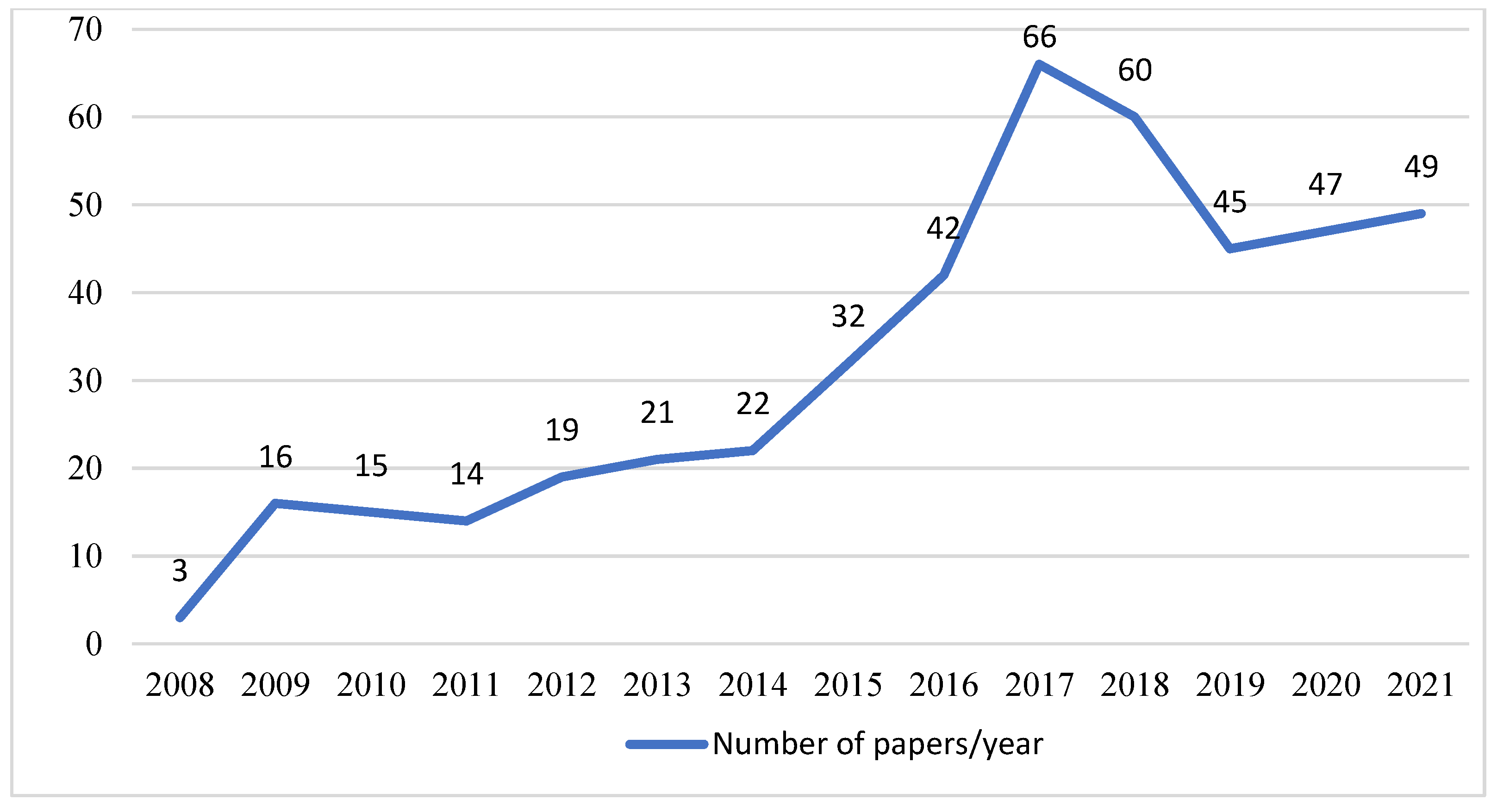
Figure 31.
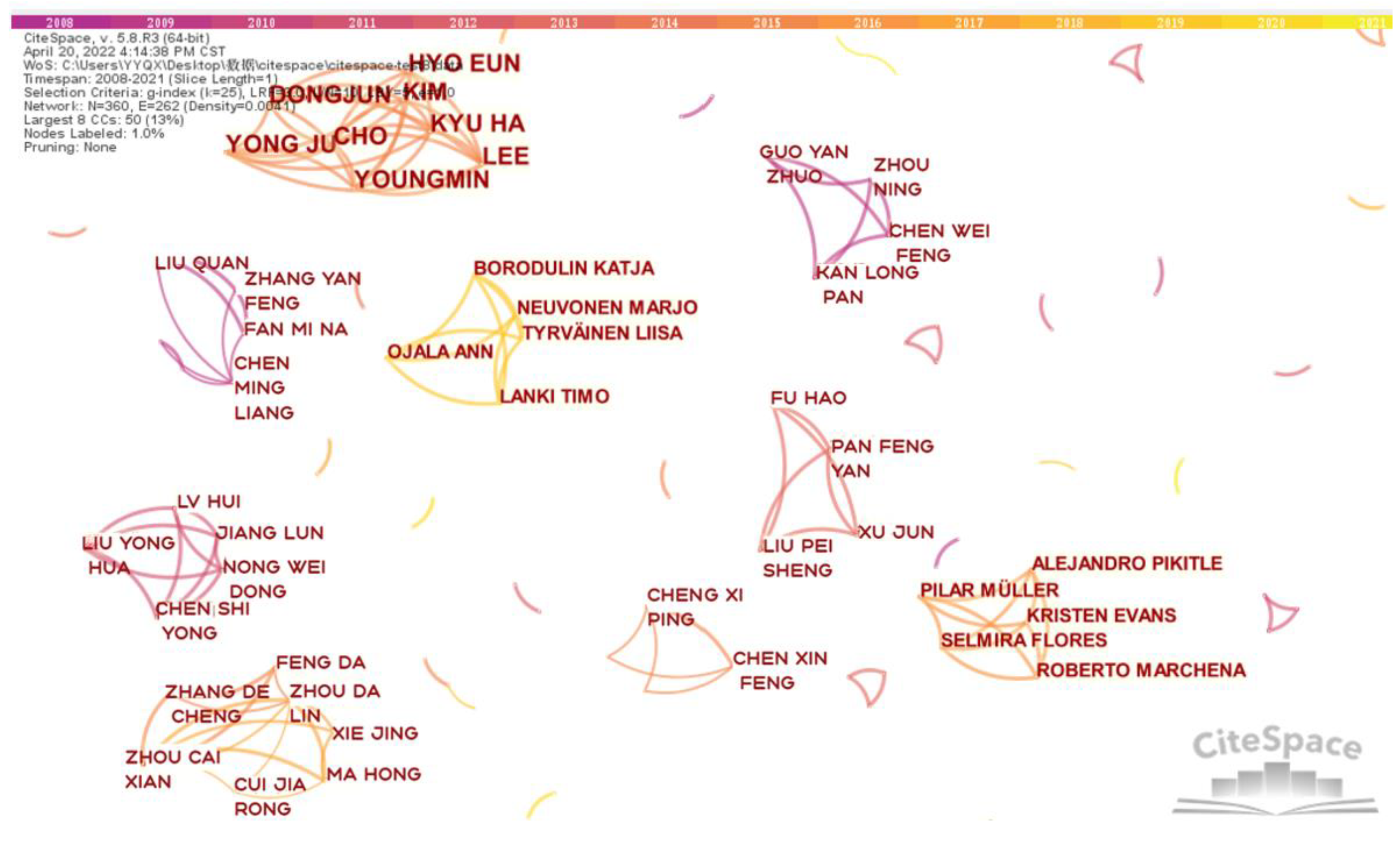
][13]. Another is research on the under-forestry economy. Using AHP, DEA, and a fuzzy comprehensive evaluation method constructs an evaluation system model of the comprehensive benefits of the under-forestry economy [66][14].
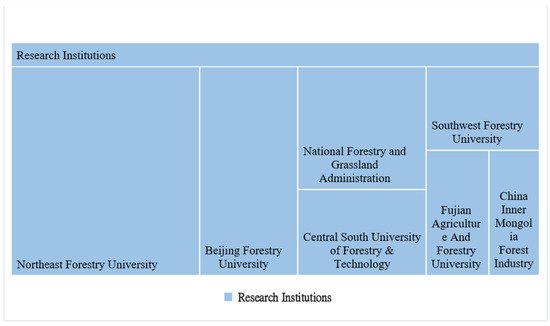
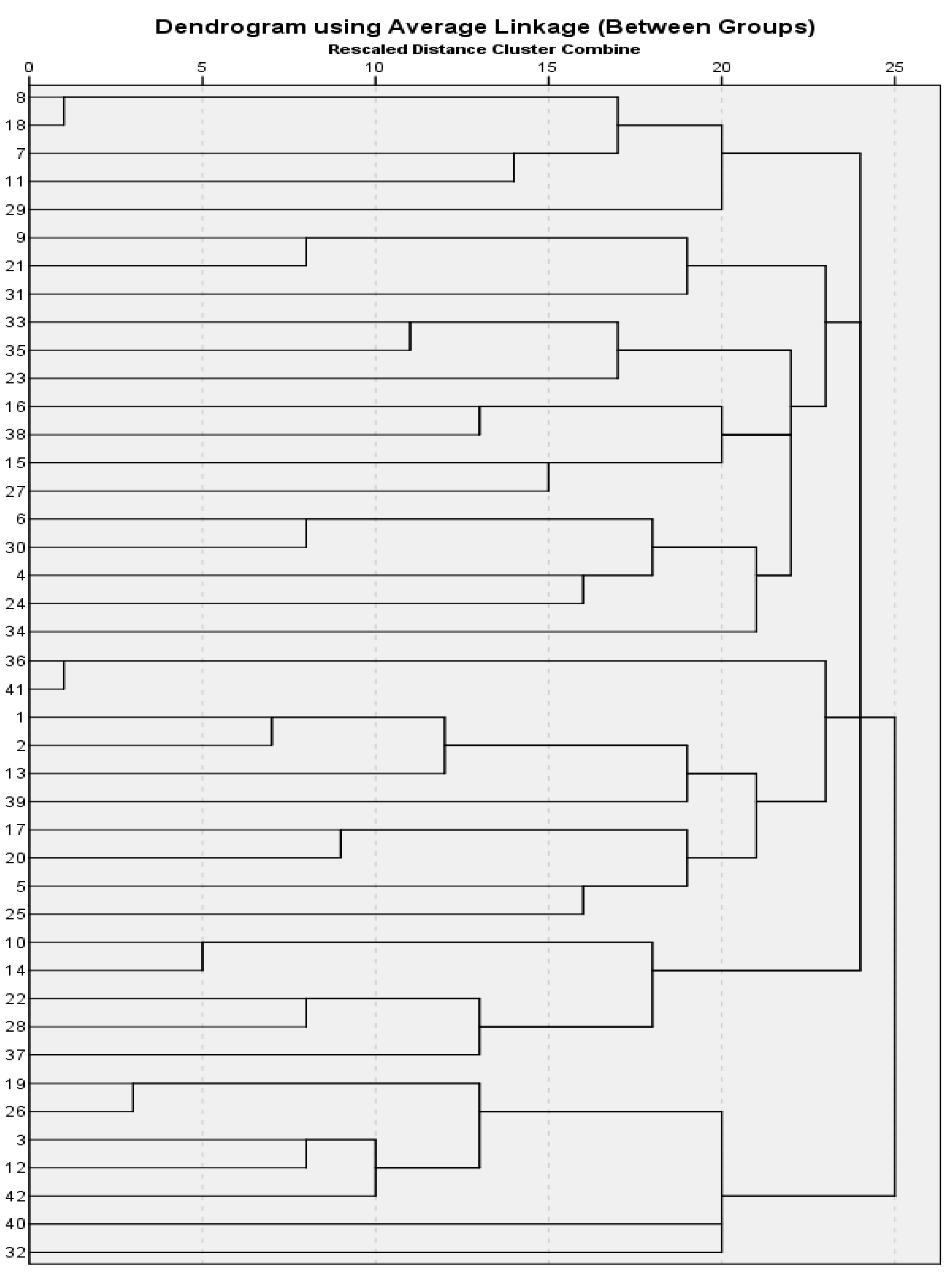
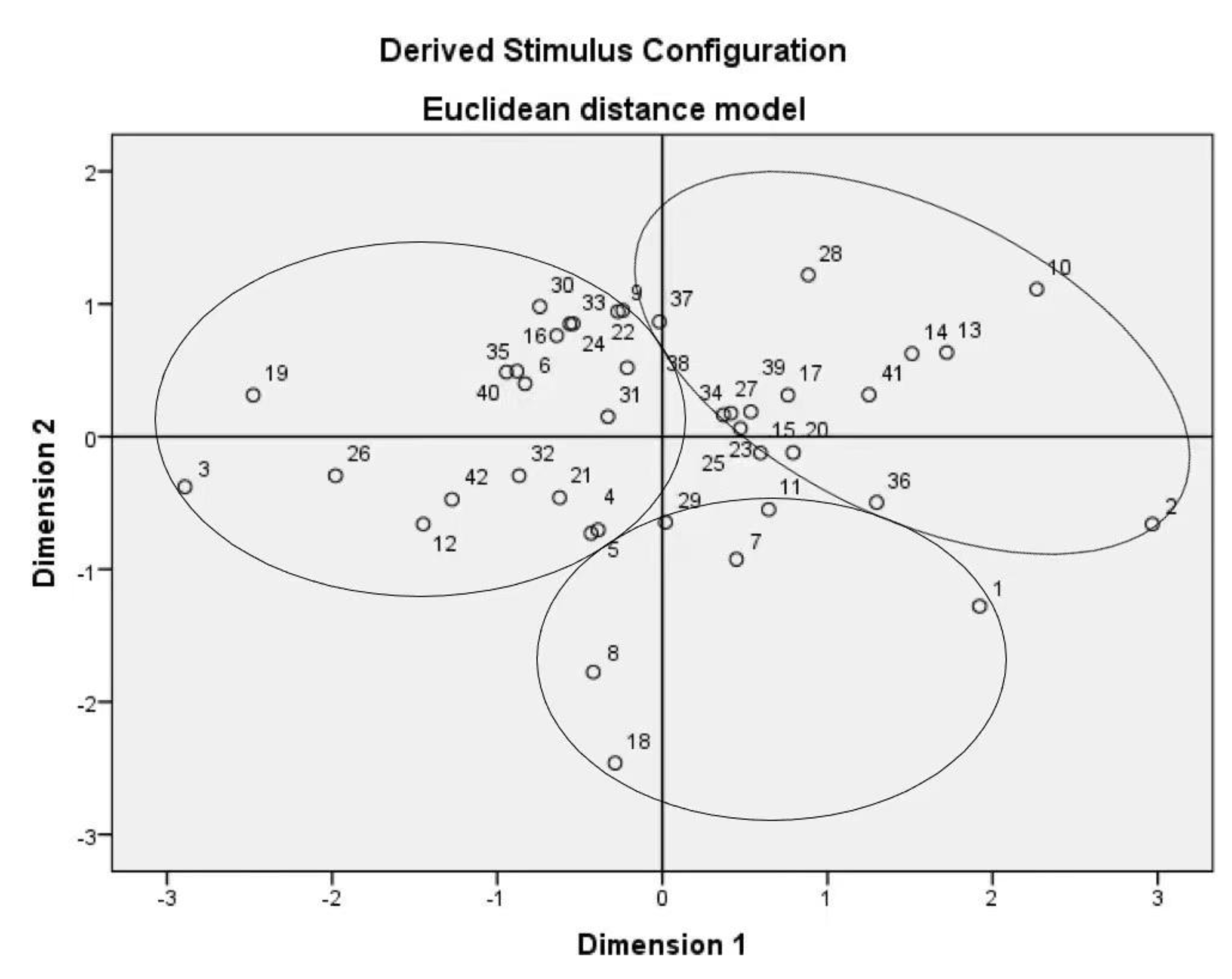
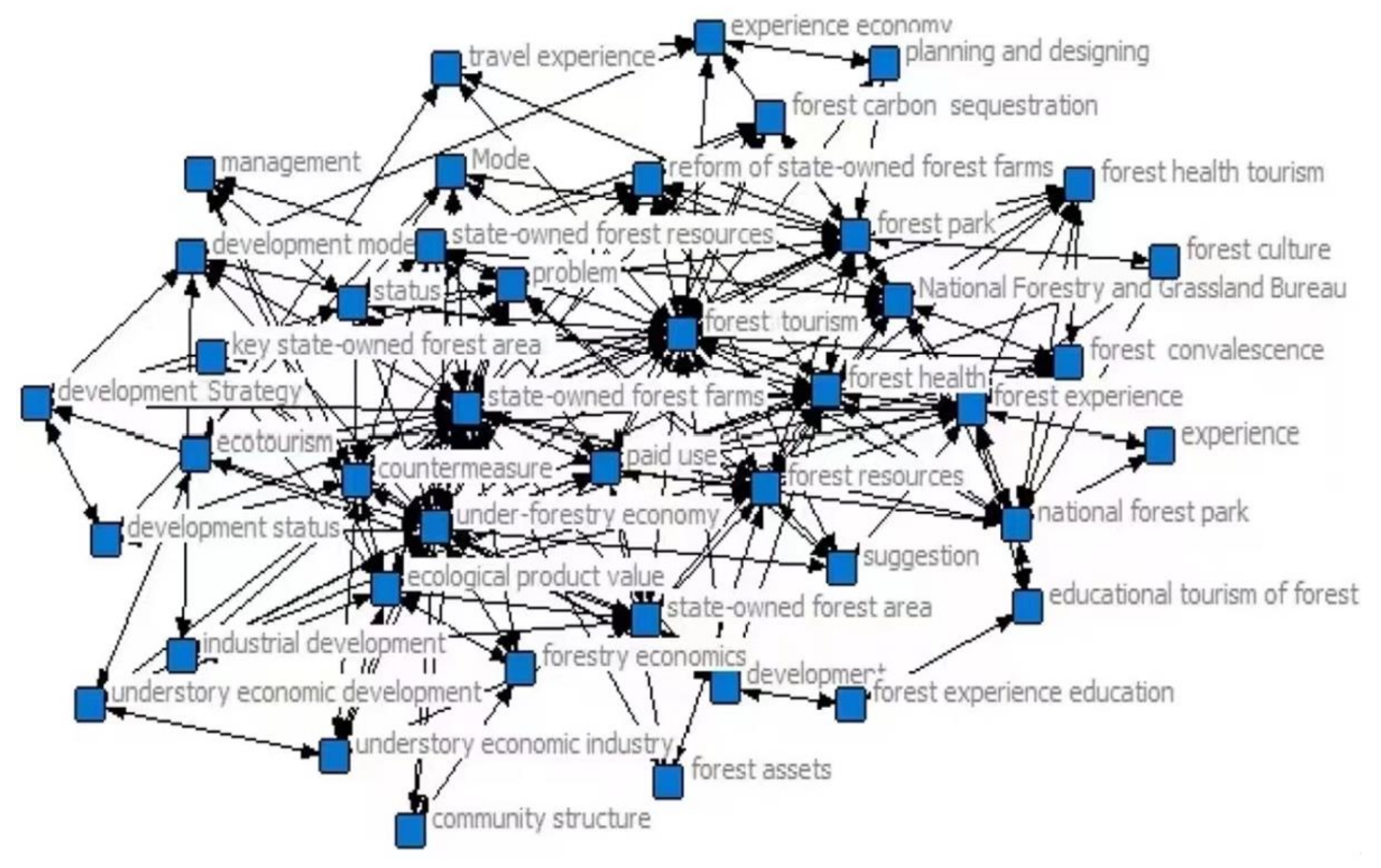
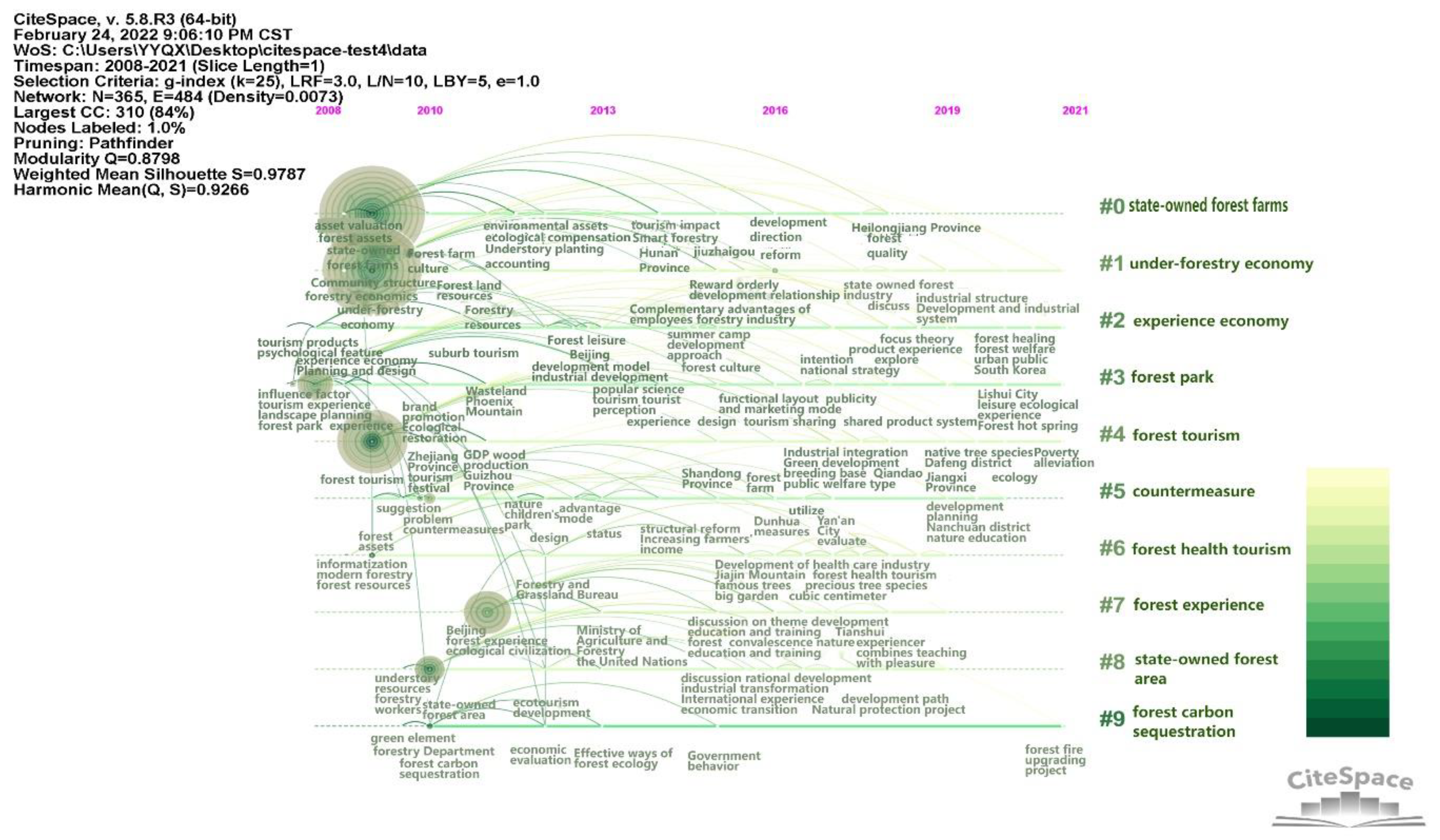
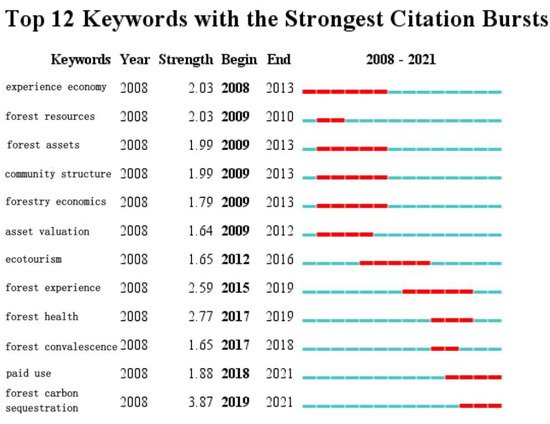
The number of papers on the paid use of state-owned forest resources in CNKI from 2008 to 2021.
From the statistical table of authors shown in Table 1 and Figure 42, the above statistical results show that although core groups of authors with a certain influence have been formed, the core authors account for 29.27%, and the research impact is still scattered and weak. There is a lack of in-depth and sustainable research, which may be related to the fact that paid use is still in the promotion stage and lacks relevant systems and an operational supervision mechanism. From the statistical table of fund projects shown in Table 2, the state, ministries, commissions, provinces, and universities have attached great importance and provided support to the paid use of state-owned forest resources, and the quality of papers has gradually improved. However, some studies have shown that the marginal efficiency of scientific research projects is decreasing [75][10]. It is necessary to conduct an in-depth review of research results in various fields. From Table 3 and Figure 53, It can be concluded that universities are the main battlefield of this research field. Social departments such as government functional institutions and professional associations are less engaged, indicating that academic research and actual management work in this field are misaligned and disjointed.
Table 1. Statistical table of authors (part).
| Number | Author | Frequency | Percentage | Cumulative Percentage |
|---|---|---|---|---|

Figure 42. Analysis of co-author network (part).
Table 2. Statistical table of fund projects.
| Fund Level | Fund Type | Number of Papers |
|---|
Statistical table of institutions (Top 10).
| Rank | Research Institutions | Number of Papers | Percentage | |
|---|---|---|---|---|
| Rank | Research | Institutions | Number of Papers | |
| 1 | Daling Zou | 7 | 1.552 | |
| National level | National Social Science Foundation | 7 | 1.552 |
Table 54. High-frequency keywords.
| Rank | Keywords | Frequency | Rank | Keywords | Frequency | Rank | Keywords | Frequency | |||||
|---|---|---|---|---|---|---|---|---|---|---|---|---|---|
| 11.43% | |||||||||||||
| 1 | State-owned forest farms | 104 | 15 | Understory economic development | 10 | 29 | Forest assets | 6 | |||||
| 2 | Hong Ma | 6 | 1.330 | 2.882 | |||||||||
| National Natural Science Foundation of China | |||||||||||||
| 2 | 8 | Under-forestry economy | 94 | 16 | Problem | 10 | 30 | Planning and designing | 3 | Yukun Cao | 5 | 1.109 | 3.991 |
| 6 | National Science and Technology Support Plan | 1 | |||||||||||
| 3 | Forest experience | 60 | 17 | Development Strategy | 4 | Hongge Zhu | 4 | 0.887 | 4.878 | ||||
| Ministerial level | 5 | ||||||||||||
| 1 | |||||||||||||
| 10 | |||||||||||||
| 31 | Forest culture | 6 | |||||||||||
| Humanities (Philosophy) Social Science Foundation | of the Ministry of Education |
9 | |||||||||||
| 4 | Forest tourism | 57 | 18 | Paid use | 9 | 32 | Jianyong He | 4 | 0.887 | 5.765 | |||
| 23.57% | Forest experience education | 6 | |||||||||||
| 5 | Forest health | 53 | 19 | Forest health tourism | 8 | 33 | Suggestion | 6 | 6 | Xiule Zhang | 3 | 0.665 | 6.430 |
| 6 | Forest park | 35 | 20 | Development mode | 8 | 34 | Key state-owned forest area | 5 | 7 | Lee | 3 | 0.665 | 7.095 |
| 8 | Xiangyue Liu | 3 | 0.665 | 7.760 | |||||||||
| Central University Funding Project | 11 | 9 | Minyan Zhao | ||||||||||
| Northeast Forestry University | National Development and Reform Commission Project | 2 | 3 | ||||||||||
| National Forestry and Grassland Administration Project | 10 | ||||||||||||
| 7 | State-owned forest area | 26 | 21 | Forest carbon sequestration | 8 | 35 | Forestry economics | National Bureau of Statistics Project | 0.665 | 8.425 | |||
| 1 | |||||||||||||
| Provincial level | Provincial (Philosophy) Social Science Foundation | 39 | 43.57% | 10 | Delin Su | 3 | 0.665 | 9.091 | |||||
| 25 | Provincial Natural Science Foundation | 1 | 11 | Caixian Zhou | 3 | 0.665 | 9.756 | ||||||
| Scientific Research Fund of Provincial Education Commission | 13 | 12 | Xinfeng Chen | 3 | |||||||||
| Provincial Postdoctoral Funding | 8 | 0.665 | |||||||||||
| Department level | Office of Science and Research Fund Project | 6 | 5% | ||||||||||
| 6 | Fujian Agriculture And Forestry University; | 5 | |||||||||||
| 2 | 10.421 | ||||||||||||
| 13 | Xiping Cheng | 3 | 0.665 | 11.086 | |||||||||
| 14 | Aijing Yao | 2 | 0.444 | 11.530 | |||||||||
| 15 | Yongde Zhong | 2 | 0.444 | 11.974 | |||||||||
| Beijing Forestry University | 10.71% | ||||||||||||
| Total | 140 | 100% |
Table 3.
| 13 | |||||
| 7 | China Inner Mongolia Forest Industry | 4 | |||
| 3 | National Forestry and Grassland Administration | 10 | 8 | Chinese Academy of Forestry | 4 |
| 4 | Central South University of Forestry & Technology | 7 | 9 | Heilongjiang Academy of Forestry | 4 |
| …… | |||||
| 5 | Southwest Forestry University | 6 | 10 | State-Owned Gaofeng Forest Farm of Guangxi Zhuang Autonomous Region | 4 |
| Department Level Soft Science Project | |||||
| 1 | |||||
| Municipal level | Municipal Social Science Project | 6 | 5.72% | ||
| …… | …… | …… | …… | ||
| Municipal Soft Science Project | 2 | ||||
| School level | University Funding Project | 15 |

Figure 53. Statistical chart of institutions (Top 10).
Secondly, the results from the perspective of bibliometrics are analyzed. As can be seen from the high-frequency keywords shown in Table 54, research on the paid use of state-owned forest resources is very rich, including listing paid use ways such as forest tourism, and the exploration of paid use modes and system management. According to Figure 64, Figure 75 and Figure 86, combined with the actual connotation of each high-frequency keyword, the sample documents divide into three topics. One is research on the development status of paid use. The paid use is based on the utility value theory. Although forest resources are not commodities, they have been used by consumers and can provide a measure of economic benefits to the global ecosystem on this basis [9][11]. A paid use system and a supervision system reflecting the market situation and the value of resources have not been established in China. One is research on forest tourism and forest health. Under effective management, there are multiple stakeholders in the management of paid forest use. Multi-stakeholder benefits should be the goal to achieve sustainable forest development. This is consistent with the research conclusion of Pelyukh et al. and Yao et al. [16,47][12
| 5 | ||||||||
| 8 | ||||||||
| Forest resources | ||||||||
| 16 | ||||||||
| 22 | State-owned forest resources | 7 | 36 | Management | 5 | |||
| 9 | Reform of state-owned forest farms | 16 | 23 | Development | 7 | 37 | Educational tourism of forest | 5 |
| 10 | Countermeasure | 15 | 24 | Experience economy | 7 | 38 | Ecotourism | 5 |
| 11 | Ecological product value | 14 | 25 | Industrial development | 7 | 39 | Mode | 5 |
| 12 | National forest park | 14 | 26 | National Forestry and Grassland Bureau | 7 | 40 | Forest convalescence | 5 |
| 13 | Development status | 13 | 27 | Understory economic industry | 7 | 41 | Experience | 5 |
| 14 | Travel experience | 10 | 28 | Status | 7 | 42 | Community structure | 5 |

Figure 64. Cluster analysis of the paid use of state-owned forest resources.

Figure 75. Multidimensional scaling of the paid use of state-owned forest resources.

Figure 86. Co-occurrence network of paid use of state-owned forest resources.
Thirdly, the results from the perspective of time trend changes are analyzed. The research on the paid use of state-owned forest resources is based on the reform practices of state-owned forest farms and state-owned forest areas. The relevant theoretical research and policy formulations are derived from the solutions to practical problems. According to Figure 97 and Figure 108, in the research from 2008 to 2010, scholars paid more attention to “state-owned forest farms”, “under-forestry economy”, “forest park”, and “forest tourism”. The explosion point of the “experience economy” was from 2008 to 2013. This means that this field received continuous attention. Forest experience, forest tourism, and forest health are different development methods based on the experience economy. Most of the research on “forest assets” and “asset evaluation” focused on the period from 2009 to 2013. The research topics in this field have gradually become enriched, including “ecotourism”, “forest experience”, “forest health”, and “forest carbon sequestration” from 2016 till now. According to the asset management theory, forest resources are a kind of resource asset. The paid use of forest resources requires bringing them into a state-owned asset management system and managing property rights by scientific principles and economic laws. Considering forest resources as assets, clarifying property rights, and forming a pricing mechanism can truly reflect the ownership of forest resources by the state and the people economically, and ensure the preservation and appreciation of state-owned forest resource assets. The economic benefits generated by forest carbon sequestration are an indispensable part of paid use. Forest ecosystems can achieve the effect of carbon sequestration while reserving energy [20][15]. Given the continuity of burst words, the research on paid use and “forest carbon sequestration” are still technical branches worthy of attention in the future.

Figure 7. Timeline visualization of the paid use of state-owned forest resources.

Figure 8. Detection of the burst words on the paid use of state-owned forest resources.
3. Conclusions
In this restudyearch, 451 documents on the paid use of state-owned forest resources in the CNKI database from 2008 to 2021 were selected as samples, and statistical analysis software, such as BICOMB, SPSS, UCINET, and CiteSpace, was used to analyze the experiment. This studyresearch first identified the general statistics, the authors, the funding, the institutions, and the journals and then constructed a co-occurrence matrix and a dissimilarity matrix of high-frequency keywords. In addition, cluster analysis, MDS, and co-occurrence network analysis were carried out. In addition, time was also taken into account. A timeline visualization map was combined with the detection of burst words, and the following conclusions were drawn:
(1) In terms of the basic feature analysis, this restudyearch finds that the number of papers is rising, and high-yield authors account for 29.27% of the total documents. Core author groups with a certain influence have been formed, but the research force is relatively scattered. In addition, the support of provincially funded projects accounts for the highest proportion, reaching 43.57%. Northeast Forestry University and Beijing Forestry University pay more attention to this field, and the distribution density of journals in the core zone is 13.64. Moreover, there is a relatively stable number of journals in this research field.
(2) According to the results of keyword cluster analysis and MDS, the research can be divided into three topics: The development status of paid use, forest tourism and forest health, and the under-forestry economy (under-forestry planting, breeding, and product processing). At present, state-owned forest resources in China have not established a paid-use system or a supervision mechanism reflecting market supply and demand and resource value. Therefore, the property rights structure of state-owned forest resources needs to be clearly defined. A scientifically based paid-use system and ex-post supervision mechanism should be established, to promote reform. The government should actively develop forest tourism and forest health projects that meet the needs of different consumers and promote the transformation of resources into benefits. Furthermore, according to the differences in resource endowments in different regions, targeted strategies should be implemented to improve the efficiency of understory economic development and the comprehensive benefits to the economy, society, and ecology.
(3) According to the analysis results of the co-occurrence network, keywords such as “state-owned forest farms”, the “under-forestry economy”, “forest tourism”, “ecological product value”, and “forest health” are in the core position, and they are considered important in this field. According to the timeline visualization map and the detection of burst words, the intermediary centralities of “state-owned forest farms” and the “under-forestry economy” are the highest, followed by “forest tourism” and “forest experience”, etc. With time and the promulgation of policies, the research focus in this field has gradually shifted from “forest assets” and “forestry economics” to “ecotourism” and “forest health”. The research on the development status of paid use and “forest carbon sequestration” is a technical branch worthy of attention.
Research contents can be divided into the following five points. Firstly, the research of state-owned forest resources is not limited to forest tourism, forest health, and the under-forestry economy. Moreover, whether the value conversion of ecological products, carbon sink trading, and ecological security can be achieved through quantification is worth discussing in future research. Secondly, the lack of an efficiency evaluation system for the paid use of state-owned forest resources makes it impossible to compare and evaluate its reform effect, so it is difficult to produce a more efficient model. The construction of an efficient evaluation system should have more attention paid to it in the future. Thirdly, an evaluation system of state-owned forest resources assets needs to be established, and a fair evaluation of the paid use of forest resources is required. How a pricing model of forest resource assets can be constructed to fairly evaluate the right to use forest land is a practical problem that needs to be solved. Fourthly, property rights about state-owned forest resources are not clearly defined. There are multiple leaders in the management system, and the hierarchy of power and responsibility is not clear. The departments in charge of state-owned forests are burdened with administrative functions. Simultaneously, they are responsible for ownership management and supervision. Furthermore, how ownership and use rights can be separated is worthy of investigation. Finally, the state-owned forest resource market is not mature, and a developed market system has not been fully formed. Thus, the role of the market and policies in promoting the development of the paid use of forest resources, as well as how the economic, social, and ecological benefits of the state-owned forest resource management in both government and the market can be maximized, will remain areas of research focus for a considerable amount of time. In conclusion, research on the paid use of state-owned forest resources in China is an important research field.
References
- United Nations Department of Economic and Social Affairs. United Nations Strategic Plan for Forests, 2017–2030. 2017. Available online: https://www.un.org/esa/forests/wp-content/uploads/2016/12/UNSPF_AdvUnedited.pdf (accessed on 23 March 2022).
- United Nations Department of Economic and Social Affairs. United Nations Forest Instrument. 2016. Available online: https://www.un.org/esa/forests/documents/un-forest-instrument/index.html (accessed on 23 March 2022).
- United Nations Department of Economic and Social Affairs. Transforming Our World: The 2030 Agenda for Sustainable Development. 2015. Available online: https://sdgs.un.org/2030agenda (accessed on 11 March 2022).
- State Council of China. Guiding Opinions on the Reform of the System of Paid Use of Natural Resource Assets Owned by the Whole People. Available online: http://www.gov.cn/zhengce/content/2017-01/16/content_5160287.htm (accessed on 3 March 2022).
- Ceccherini, G.; Duveiller, G.; Grassi, G.; Lemoine, G.; Avitabile, V.; Pilli, R.; Cescatti, A. Abrupt increase in harvested forest area over Europe after 2015. Nature 2020, 583, 72–77.
- FAO. Global Forest Resources Assessment 2020—Key Findings. 2020. Available online: https://www.fao.org/documents/card/en/c/ca8753en (accessed on 20 March 2022).
- National Forestry and Grassland Administration. China Forest Resources Report (2014–2018); China Forestry Press: Beijing, China, 2019; pp. 5–6.
- The Suggestions on Formulating the Fourteenth Five-Year Plan for National Economic and Social Development and the Long-Term Goals for 2035. Available online: http://www.gov.cn/zhengce/2020-11/03/content_5556991.htm?trs=1 (accessed on 11 March 2022).
- National Forestry and Grassland Administration of China. Suggestions on Accelerating the Paid Use of Forest Resources Assets in State-Owned Forest Areas. Available online: https://www.forestry.gov.cn/main/4861/20201211/165925119603952.html (accessed on 20 February 2022).
- Shang, H.P.; Ye, J.; Zhao, P.P. Public finance efficiency in scientific research in my country: Inefficiency and waste—Evidence from the output of the National Natural Science Foundation of China and the Social Science Foundation of China. Sci. Res. 2012, 30, 1476–1487+1475.
- Costanza, R.; D’Arge, R.; De Groot, R.; Farber, S.; Grasso, M.; Hannon, B.; Limburg, K.; Naeem, S.; O’Neill, R.V.; Paruelo, J.; et al. The value of the world’s ecosystem services and natural capital. Nature 1997, 387, 253–260.
- Pelyukh, O.; Lavnyy, V.; Paletto, A.; Troxler, D. Stakeholder analysis in sustainable forest management: An application in the Yavoriv region (Ukraine). For. Policy Econ. 2021, 131, 102561.
- Yao, X.Q.; Ding, W.E.; Lin, H.; He, P.K. An Overview of China’s Forest Tourism Development. For. Surv. Plan. 2007, 32, 75–80.
- Du, Y.; Zhao, H.M.; Li, C.; Chen, J.; Xue, Y. Fuzzy comprehensive evaluation and application of economic benefits under forest. For. Resour. Manag. 2016, 6, 111–115.
- Koponen, K.; Soimakallio, S.; Kline, K.; Cowie, A.; Brandão, M. Quantifying the climate effects of bioenergy–choice of reference system. Renew. Sustain. Energy Rev. 2018, 81, 2271–2280.
More
